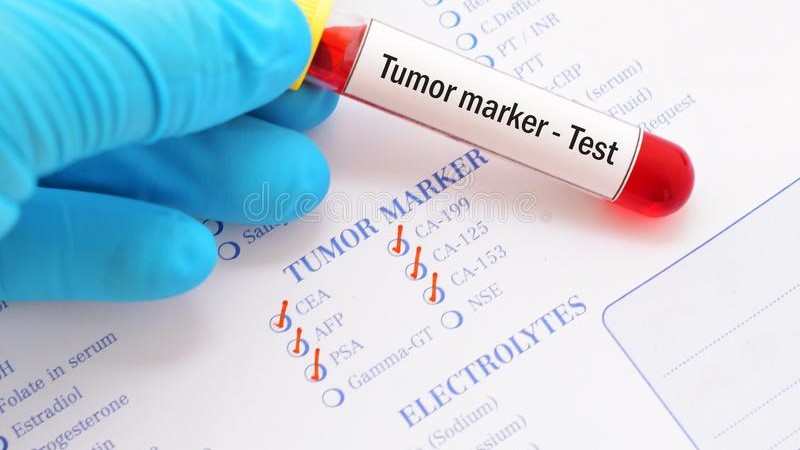What are tumor markers?
Tumor markers are substances (proteins, enzymes, hormones etc.) that are secreted in the body аs a response of a benign or malignant occurrences. The measurement and identification of the tumor markers is important for diagnosis and for monitoring of the progress, course of the disease and the success of the treatment..
What is the meaning of the values of tumor markers?
During chemotherapy, hormone and radiation therapy, the change of the values of the markers in the blood can be used to evaluate the effectiveness of the therapy. If the values are declining, it’s an indication that there is a respond to the treatment. Otherwise, elevated tumor markers in medical examinations suggest recurrent tumor or presence of metastasis (even six months earlier than the X-ray or ultrasound examination). Therefore, the therapeutic strategy should be changed.
Review on some specific tumor-markers:
AFP (α-fetoprotein)
The levels of alpha-fetoprotein in the serum serves as a marker for hepatocellular carcinoma and metastatic liver tumors, as well to assess the risk of birth defects (Neural tube defects, Down syndrome).
BR – MA (CA 15-3) (“Breast-cancer antigen”- 15-3)
This marker is the most important in the control of the disease in patients со with malignant neoplasm of the breast.The amount of the value of the marker largely depends on the disease activity and can be used in differential diagnostic purposes in diseases of the breast of women. Common determination of CA 15-3 and CEA reveals metastasis of breast cancer with 80% of confidence.
GI – MA (CA 19 – 9)
This marker has clinical utility mainly in tumors of the pancreas and biliary tract. Tumors that frequently can provide elevated values of CA 19-9 are: malignancies of the pancreas, cancer of the biliary tract, cancer of stomach and colon.
OM – MA ( CA 125)
CA 125 primarily has a value as tumor marker for detection of malignant neoplasms of the ovary. Other diseases that can provide elevated values of CA 125 are: liver cirrhosis, acute pancreatitis (inflammation of the pancreas), acute olecistitis (inflammation of the gallbladder) and other benign gynecological diseases or inflammations.
CA 72-4
Tumor marker for gastric cancer,with specificity higher than 95%. The values of this marker in serum coincide with the stage of the disease. The more advanced stage of the disease is, the higher serum values of CA 72-4 are.
S 100 протеин
S – 100 has a prognostic significance and diagnostic value in patients with malignant melanoma.
СЕА (carcino-embryonic antigen)
Non-specific tumor marker which is determined along with specific tumor markers for monitoring and prognosis, in patients with different types of cancers, particularly colorectal cancers. Determining the values of CEA plays has crucial role in neoplastic/colon cancer, where the levels of the values is directly dependent on the stage of the tumor
PAP (prostatic acid phosphatase) и PSA (prostate specific antigen)
PAP, along with PSA are markers for monitoring patients suffering from prostate cancer. For early detection of the prostate cancer despite clinical examination it’s important to identify markers that would prove the existence of the disease. Total PSA, acid phosphatase and PAP (prostatic acid phosphatase) are the most important markers for early detection of prostate cancer.
HE-4 (human epididymis protein 4) and HE-4 + CA-125 (ROMA INDEX)
HE-4 (human epididymis protein 4) is a serum biomarker whose concentration increases significantly in patients with epithelial ovarian cancer and has better sensitivity and specificity than the CA-125 marker. It is used as an aid in diagnosis, as well as monitoring the response to therapy in patients with ovarian cancer.
Combined with the CA-125 marker, the sensitivity and specificity of the CA-125 marker increased significantly
The combination of HE-4 + CA-125 (ROMA INDEX) is a new tool for differential diagnosis in determining whether the tumor mass in the small pelvis is benign or malignant, both in premenopausal and postmenopausal women, and provides stratification of the risk and direction for further treatment .
ROMA ALGORITHM for calculating the risk of epithelial ovarian cancer is used for stratification of patients into groups of low or high risk.
Women in the progenoma
ROMA> 12.5% = high risk of ovarian epithelial carcinoma
ROMA ≤ 12.5% = low risk of ovarian epithelial carcinoma
Postmenopausal women
ROMA> 14.3% = high risk of ovarian epithelial carcinoma
ROMA ≤ 14.3% = low risk of ovarian epithelial carcinoma

